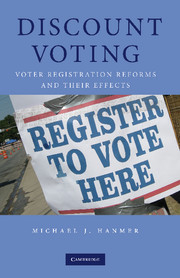Book contents
- Frontmatter
- Contents
- Acknowledgments
- Introduction
- 1 Motivation and a New Theoretical Framework
- 2 The Purposeful Adoption of Election Day Registration
- 3 Election Day Registration by Choice and by Federal Mandate
- 4 Motor Voter by Choice and by Federal Mandate
- 5 Registration and Voting in the Post-NVRA Era
- 6 Election Reform and the Composition of the Electorate
- 7 EDR on the Ground and Prospects for the Future
- APPENDICES
- References
- Index
5 - Registration and Voting in the Post-NVRA Era
Published online by Cambridge University Press: 02 December 2009
- Frontmatter
- Contents
- Acknowledgments
- Introduction
- 1 Motivation and a New Theoretical Framework
- 2 The Purposeful Adoption of Election Day Registration
- 3 Election Day Registration by Choice and by Federal Mandate
- 4 Motor Voter by Choice and by Federal Mandate
- 5 Registration and Voting in the Post-NVRA Era
- 6 Election Reform and the Composition of the Electorate
- 7 EDR on the Ground and Prospects for the Future
- APPENDICES
- References
- Index
Summary
Previous chapters have shown that the selection of election laws is purposeful, that the overall effects of the two registration reforms projected to have the largest impact on turnout have resulted in much smaller than anticipated (and smaller than previously estimated) increases in turnout, and that the magnitude of the effects varies based on the social and political contexts into which the reforms are placed. That is, lowering the costs of participation does nothing directly, and apparently very little indirectly (I take this up in Chapter 7) to engage those who do not want to vote. Having estimated the overall effects of election day registration (EDR) and motor voter laws, as implemented by the states on their own and via impetus from the federal government, the present chapter provides a bridge to the analysis of how the effects vary across individual characteristics. In this chapter, I explore what can be learned from self-reports of registration behavior when individuals are asked about the timing and method they used to register.
Beginning in 1996, Current Population Survey (CPS) Voter Supplement respondents who voted or were registered but did not vote were asked a series of questions regarding when, relative to the implementation of the National Voter Registration Act (NVRA), and by what means (at a government office, by mail, and so on) they registered.
- Type
- Chapter
- Information
- Discount VotingVoter Registration Reforms and their Effects, pp. 126 - 144Publisher: Cambridge University PressPrint publication year: 2009

